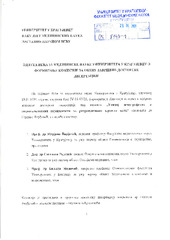Приказ основних података о дисертацији
Uticaj demografskih i socioekonomskih nejednakosti na reproduktivno zdravlje žena
| dc.contributor.advisor | Đurić, Janko | |
| dc.contributor.other | Radovanović, Snežana | |
| dc.contributor.other | Varjačić, Mirjana | |
| dc.contributor.other | Radević, Svetlana | |
| dc.contributor.other | Miličić, Biljana | |
| dc.creator | Đorđević, Gordana | |
| dc.date.accessioned | 2021-04-19T09:37:34Z | |
| dc.date.available | 2021-04-19T09:37:34Z | |
| dc.date.issued | 2020-12-25 | |
| dc.identifier.uri | http://eteze.kg.ac.rs/application/showtheses?thesesId=7931 | |
| dc.identifier.uri | https://fedorakg.kg.ac.rs/fedora/get/o:1325/bdef:Content/download | |
| dc.identifier.uri | https://nardus.mpn.gov.rs/handle/123456789/18243 | |
| dc.description | SAŽETAK- Uvod: Zdravstveno stanje žena rezultat je složene interakcije mnogobrojnih faktora. Identifikacija tih faktora, analiza zdravlja žena, rana dijagnoza i pravovremeno, adekvatno, efikasno lečenje i upravljanje kvalitetom zdravlja i kvalitetom života su odlučujići činioci koji utiču na smanjenje nejednakosti u reproduktivnom zdravlju žena. Cilj: Cilj studije je ispitivanje demografskih i socioekonomskih nejednakosti u reproduktivnom zdravlju žena starosti 15 i više godina u Srbiji. Materijal i metod: Za rezultate ove doktorske disertacije korišćen je uzorak od 7864 osoba ženskog pola starosti ≥15 godina iz Nacionalnog istraživanja zdravlja stanovništva Srbije tokom 2013. godine sprovedenog od strane Ministarstva zdravlja i Republičkog instituta za javno zdravlje Srbije, a poštujući metodologiju Evropskog istraživanja zdravlja – drugi talas (EHIS-wave 2). Rezultati: Rezultati istraživanja pokazali su da 62,8% žena u Srbiji ima svog ginekologa. U ukupnom uzorku žena 56,2% njih je bilo seksualno aktivno. Posmatrano prema demografskim i socioekonomskim karakteristikama, žene reproduktivne dobi, iz vangradskih naselja (39,2%), udate (45,0%) i zaposlene (39,1%) značajno češće koriste nesigurne metode kontracepcije. Analiza pokazuje statističku značajnost povezanosti unutar demografskih i socio-ekonomskih karakteristika i poseta ginekologu kao i inicijative za skrining preglede. Viši stepen obrazovanja udatih žena, dobra procena sopstvenog zdravlja, zaposlenost i mesto stanovanja u gradu, pozitivni su aspekti reproduktivnog zdravlja žena naših područja, dok su negativni gojaznost i prisustvo hroničnih bolesti. Zaključak: Utvrđivanje i značaj relevantnih činilaca za reproduktivno zdravlje, definisano u granicama savremenog shvatanja reproduktivnog zdravlja, veoma je bitno sa stanovišta zdravstvene politike koja se vodi u uslovima ograničenih resursa. U našoj zemlji to ima poseban značaj, kako zbog negativnog nataliteta, tako i zbog ograničenih resursa. | sr |
| dc.description | ABSTRACT- Introduction: Women's health is the result of a complex interaction of many factors. Identification of these factors, analysis of women's health, early diagnosis and timely, adequate, effective treatment and management of health and of quality of life are decisive factors influencing the reduction of inequalities in women's reproductive health. Aim: The aim of the study is to examine demographic and socioeconomic inequalities in the reproductive health of women aged 15 and older in Serbia. Material and method: For the results of this doctoral dissertation, a sample of 7 864 females aged 15 and older from the National Survey of Health of the Population of Serbia from 2013 conducted by the Ministry of Health and the Republic Institute of Public Health of Serbia was used, respecting the methodology of the European Health Survey – second wave (EHIS-wave 2). Results: The results of the research showed that 62.8% of women in Serbia have their own gynecologist. In the total sample of women, 56.2% of them were sexually active. Observed according to demographic and socio-economic characteristics, women of reproductive age from suburban settlements (39.2%), married (45.0%) and employed (39.1%) use insecure methods of contraception significantly more often. The analysis shows that there is a statistically significant correlation between demographic and socio-economic characteristics, and gynecologist visits as well as screening initiatives. Highly educated respondents, employed, of good financial status and from urban areas visited gynecologists more often and most often performed screening examinations on their own initiative, compared to the poorest who were most often tested on the advice of a doctor. Conclusion: Determining the relevant factors and their importance for reproductive health defined within the limits of the modern understanding of reproductive health is very important from the point of view of health policy conducted in conditions of limited resources. In our country, this has a special significance, both due to the negative birth rate and due to limited resources. | en |
| dc.format | application/pdf | |
| dc.language | sr | |
| dc.publisher | Универзитет у Крагујевцу, Факултет медицинских наука | sr |
| dc.rights | openAccess | en |
| dc.rights.uri | https://creativecommons.org/licenses/by-nc-nd/4.0/ | |
| dc.source | Универзитет у Крагујевцу | sr |
| dc.title | Uticaj demografskih i socioekonomskih nejednakosti na reproduktivno zdravlje žena | sr |
| dc.type | PhD thesis | |
| dc.rights.license | BY-NC-ND | |
| dcterms.abstract | Ђурић, Јанко; Миличић, Биљана; Радевић, Светлана; Варјачић, Мирјана; Радовановић, Снежана; Ђорђевић, Гордана; Утицај демографских и социоекономских неједнакости на репродуктивно здравље жена; Утицај демографских и социоекономских неједнакости на репродуктивно здравље жена; | |
| dc.identifier.fulltext | https://nardus.mpn.gov.rs/bitstream/id/70985/Disertacija.pdf | |
| dc.identifier.fulltext | https://nardus.mpn.gov.rs/bitstream/id/70986/izvestaj_Gordana_Djordjevic-Medicinski.pdf | |
| dc.identifier.rcub | https://hdl.handle.net/21.15107/rcub_nardus_18243 |



